
N2 Chart
Encyclopedia
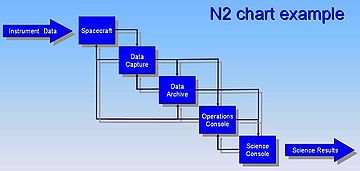
Diagram
A diagram is a two-dimensional geometric symbolic representation of information according to some visualization technique. Sometimes, the technique uses a three-dimensional visualization which is then projected onto the two-dimensional surface...
in the shape of a matrix
Matrix (mathematics)
In mathematics, a matrix is a rectangular array of numbers, symbols, or expressions. The individual items in a matrix are called its elements or entries. An example of a matrix with six elements isMatrices of the same size can be added or subtracted element by element...
, representing functional or physical interfaces between system
System
System is a set of interacting or interdependent components forming an integrated whole....
elements. It is used to systematically identify, define, tabulate, design, and analyze functional and physical interfaces. It applies to system interface
Interface (computer science)
In the field of computer science, an interface is a tool and concept that refers to a point of interaction between components, and is applicable at the level of both hardware and software...
s and hardware
Hardware
Hardware is a general term for equipment such as keys, locks, hinges, latches, handles, wire, chains, plumbing supplies, tools, utensils, cutlery and machine parts. Household hardware is typically sold in hardware stores....
and/or software interfaces.
The N-squared chart was invented by the systems engineer Robert J. Lano, while working at TRW
TRW
TRW Inc. was an American corporation involved in a variety of businesses, mainly aerospace, automotive, and credit reporting. It was a pioneer in multiple fields including electronic components, integrated circuits, computers, software and systems engineering. TRW built many spacecraft,...
in the 1970s and first published in a 1977 TRW internal report.
Overview
The N2 diagram has been used extensively to develop data interfaces, primarily in the software areas. However, it can also be used to develop hardwareHardware
Hardware is a general term for equipment such as keys, locks, hinges, latches, handles, wire, chains, plumbing supplies, tools, utensils, cutlery and machine parts. Household hardware is typically sold in hardware stores....
interfaces. The basic N2 chart is shown in Figure 2. The system functions are placed on the diagonal; the remainder of the squares in the N × N matrix represent the interface inputs and outputs.
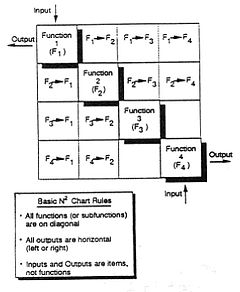 |
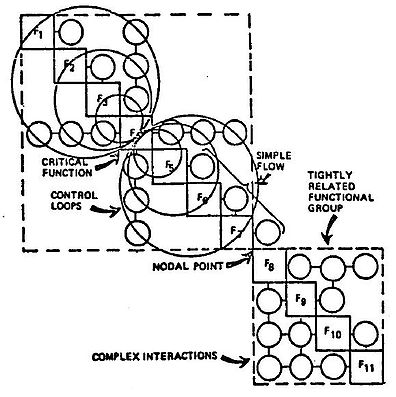 |
Where a blank appears, there is no interface between the respective functions. Data flows in a clockwise direction between functions (e.g., the symbol F1 F2 indicates data flowing from function F1, to function F2). The data being transmitted can be defined in the appropriate squares. Alternatively, the use of circles and numbers permits a separate listing of the data interfaces. The clockwise flow of data between functions that have a feedback loop can be illustrated by a larger circle called a control loop. The identification of a critical function is also shown in Figure 3, where function F4 has a number of inputs and outputs to all other functions in the upper module. A simple flow of interface data exists between the upper and lower modules at functions F7 and F8. The lower module has complex interaction among its functions. The N2 chart can be taken down into successively lower levels to the hardware and software component functional levels. In addition to defining the data that must be supplied across the interface, the N2 chart can pinpoint areas where conflicts could arise.
Number of entities
The “N” in an N2 diagram is the number of entities for which relationships are shown. This N × N matrix requires the user to generate complete definitions of all interfaces in a rigid bidirectional, fixed framework. The user places the functional or physical entities on the diagonal axis and the interface inputs and outputs in the remainder of the diagram squares. A blank square indicates that there is no interface between the respective entities. Data flows clockwise between entities (i.e., the symbol F1 ? F2 in Figure 1 indicates data flowing from function F1 to function F2; the symbol F2 = F1 indicates the feedback). That which passes across the interface is defined in the appropriate squares.The diagram is complete when the user has compared each entity to all other entities. The N2 diagram should be used in each successively lower level of entity decomposition. Figure 1 illustrates directional flow
of interfaces between entities within an N2 diagram. (In this case, the entities are functions.)
Functions on the diagonal
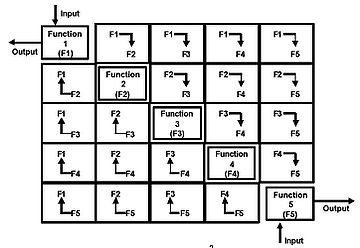
Contextual and administrative data
Each N2 diagram shall contain at a minimum the following contextual and administrative data:- Date the diagram was created
- Name of the engineer, organization, or working group that created the diagram
- Unique decimal delimited number of the functional or physical entity being diagrammed
- Unique name for the functional or physical entity being diagrammed
N2 diagrams are a valuable tool for not only identifying functional or physical interfaces, but also for pinpointing areas in which conflicts may arise with interfaces so that system integration proceeds smoothly and efficiently.
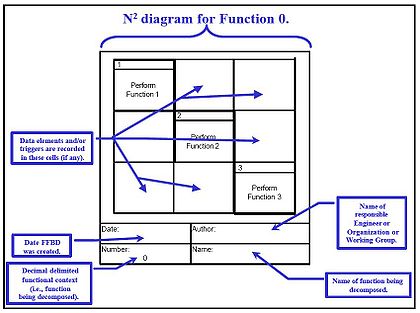
Functional flow block diagram
A Functional Flow Block Diagram is a multi-tier, time-sequenced, step-by-step flow diagram of a system’s functional flow.The FFBD notation was developed in the 1950s, and is widely used in classical systems engineering...
. Notice that in this illustration, there are no data elements or triggers. The figure illustrates the context between functions at different levels of the model.
Examples
Figure 6 is an example of the diagram’s appearance when cells are populated with data.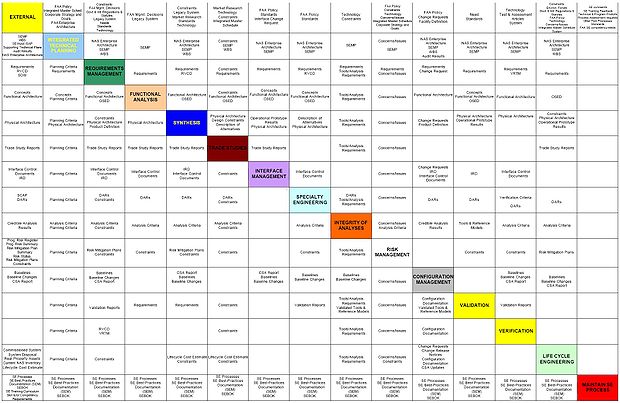
See also
- Business process mappingBusiness Process MappingBusiness process mapping refers to activities involved in defining exactly what a business entity does, who is responsible, to what standard a process should be completed and how the success of a business process can be determined. Once this is done, there can be no uncertainty as to the...
- Flow chart
- Function modelFunction modelA function model or functional model in systems engineering and software engineering is a structured representation of the functions within the modeled system or subject area....
- Function block diagramFunction block diagramA function block diagram is a block diagram that describes a function between input variables and output variables. A function is described as a set of elementary blocks. Input and output variables are connected to blocks by connection lines...
- Functional flow block diagramFunctional flow block diagramA Functional Flow Block Diagram is a multi-tier, time-sequenced, step-by-step flow diagram of a system’s functional flow.The FFBD notation was developed in the 1950s, and is widely used in classical systems engineering...

